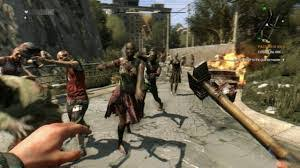Why Dying Light is the Best Game in Its Genre
In a world flooded with post-apocalyptic games and open-world survival horror titles, few manage to leave a mark as lasting and impactful as Dying Light. Released by Techland in 2015, this game redefined what players could expect from a zombie survival experience. While many titles offer horror, action, or exploration, Dying Light masterfully blends all three — and adds parkour to the mix. But what exactly makes it the best game in its genre? Let’s break it down.
1. Fluid and Immersive Parkour Mechanics
One of the most iconic features of Dying Light is its seamless parkour system. While games like Mirror’s Edge may have pioneered first-person movement, Dying Light took it and made it feel natural, fast-paced, and most importantly — necessary.
Running across rooftops, vaulting over fences, climbing buildings, and sprinting away from hordes of the infected feels fluid and empowering. The parkour system isn't just a gimmick; it's a vital tool for survival. Whether you're exploring the city during the day or running for your life at night, this mechanic keeps the adrenaline pumping.
2. Day and Night Cycle That Changes Everything
Most zombie games follow a familiar pattern — you explore, kill zombies, and maybe get spooked once in a while. Dying Light breaks that pattern with its dynamic day and night cycle.
During the day, you’re the predator. At night? You become the prey.
The terrifying "Volatiles" that emerge after sundown are faster, stronger, and deadlier. This risk-reward system adds true survival tension. Do you risk staying out at night for more loot and XP, or play it safe and wait until sunrise? Few games create such a powerful shift in tone and gameplay with just a lighting change.
3. Brutal, Satisfying Combat
Combat in Dying Light is gritty and visceral. It’s not about spraying bullets — in fact, ammo is scarce and guns are loud. Most encounters rely on melee weapons: machetes, pipes, baseball bats, and makeshift weapons crafted from scavenged parts.
The weight behind every swing, the crunch of a well-placed hit, and the blood-splattering physics all come together to make combat feel raw and meaningful. Add in slow-motion finishers and dismemberment, and it becomes some of the most satisfying melee combat in any game.
4. Deep Crafting and Customization
Surviving in Harran isn’t just about fighting and running — it’s about building. Dying Light features an impressive crafting system that encourages creativity. From electrified machetes to fire-spitting baseball bats, you can customize weapons to suit your playstyle.
The scavenging mechanics reward exploration, and crafting isn’t a boring chore — it’s exciting to build something deadly from the scraps you find in abandoned buildings.
5. Expansive Open World with Verticality
Many open-world games boast large maps, but few use verticality as well as Dying Light. The city of Harran is dense, layered, and alive. Rooftops are as important as streets, and alleys hide secrets that can save — or kill — you.
From slums to tower districts to abandoned highways, the world feels lived-in and real. It’s more than just a backdrop — it’s a character in its own right.
6. Excellent Multiplayer and Co-op Experience
Unlike many story-driven games, Dying Light doesn’t lose its charm when playing with friends. In fact, co-op mode enhances the experience. You can team up with up to three other players to tackle missions, explore, or just go on chaotic zombie-killing sprees.
There’s also a unique PvP mode called "Be the Zombie," where one player invades others’ games as a powerful Night Hunter. This asymmetrical multiplayer adds a surprising level of depth and challenge to the experience.
7. Strong Narrative and Side Missions
While Dying Light is primarily known for gameplay, its story shouldn't be overlooked. The main campaign, following Kyle Crane’s infiltration of Harran, mixes survival and politics with emotional stakes.
What makes the game shine further is its side missions. These aren't just filler — they’re stories that explore loss, desperation, and humanity in a crumbling world. You meet fascinating characters, some hopeful, some broken, but all adding to the rich tapestry of the world.
8. Longevity and Developer Support
Few studios support their games post-launch as well as Techland did with Dying Light. Years after its release, the game continued to receive updates, events, and even full expansions like The Following, which introduced drivable buggies and a whole new countryside map.
This long-term support kept the game alive and thriving, building a loyal community and proving the developers’ passion and commitment.
9. Balance of Horror and Freedom
Many zombie games lean too far into horror or action. Dying Light walks a fine line — it scares you, but it also empowers you. It lets you fight, flee, or sneak depending on your style. The horror is real, but so is the freedom.
That’s a rare balance to strike, and Dying Light does it masterfully.
10. Legacy and Influence
Even years later, few games have matched Dying Light in terms of parkour mechanics, dynamic survival systems, and melee combat. Its DNA is seen in modern zombie and survival games, but none have truly surpassed it.
Its success led to the development of Dying Light 2, but the original remains a beloved classic that many gamers still return to — a testament to its lasting impact.
Final Thoughts
While there are many survival games out there — from Dead Island to State of Decay, The Last of Us, and Days Gone — none combine intense parkour, brutal combat, rich world-building, and true fear of nightfall like Dying Light.
It’s not just a zombie game. It’s a survival experience that respects the player’s intelligence, challenges their instincts, and rewards their bravery. Whether you’re playing solo or with friends, Dying Light offers one of the most thrilling and unforgettable adventures in gaming history.
And that’s why Dying Light stands out as the best in its genre.













.jpg)
Comments
Post a Comment